Spring will be here soon - honest! How about giving your backyard friends a new home?
From: Birds & Blooms:
The Importance of Hole Size
One of the most important design elements in building any bird house is the hole size. The hole diameter will determine who or who cannot use your wren nest box. For house wrens, winter wrens and Bewick's wrens, you can make the hole diameter 1 1/8" which is also large enough for black-capped chickadees. A 1 1/4" hole will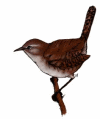 allow
Carolina wrens and white-breasted nuthatches to use the box, but
also will allow unwanted house sparrows to enter as well. Other species
of wrens such as marsh wrens, sedge wrens, cactus wrens, and canyon
wrens are not likely to use a nest box.
allow
Carolina wrens and white-breasted nuthatches to use the box, but
also will allow unwanted house sparrows to enter as well. Other species
of wrens such as marsh wrens, sedge wrens, cactus wrens, and canyon
wrens are not likely to use a nest box.I have found wide variation on hole sizes required for different wren species from 1 1/8" to 1 1/2" needed. If house sparrows are not an issue in your area, then you may want to start with a bigger hole size, such as 1 1/4", otherwise stick with the 1 1/8" hole.
Here is a wren bird house plan from the Natural Resources Conservation Service. A more detailed view is provided from the MN DNR further below (see highlighted arrow next to small image).
Wren House Plans Layout

Wren House Placement
You can place the nest box from these wren house plans 5-10 feet above the ground, under the eaves of a building or a tree limb. Wren boxes can also be firmly fixed to the side of a building or tree or can be hung freely from a wire. Carolina wrens prefer a house that is more hidden, like around shrubs or trees, than exposed and in a wide open space. We have seen wrens build nests in hanging plant baskets and even in the mouth of an old flounder skeleton that was mounted on the outside wall of a shed!To attract wrens to your backyard and to ultimately use your bird house, place
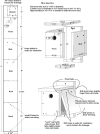 suet,
peanut butter or meal worms in nearby feeders.
suet,
peanut butter or meal worms in nearby feeders.<-Here is another more detailed diagram for wren houses from the Minnesota Division of Natural Resources. Click on the small thumbnail image to view larger plans in a new window. You can then print the plans using your browser or save the image to your computer to view or print at a later time.
- See more at: http://www.birdwatching-bliss.com/wren-house-plans.html#sthash.MewoFs2Z.dpuf
The Importance of Hole Size
One of the most important design elements in building any bird house is the hole size. The hole diameter will determine who or who cannot use your wren nest box. For house wrens, winter wrens and Bewick's wrens, you can make the hole diameter 1 1/8" which is also large enough for black-capped chickadees. A 1 1/4" hole will allow
Carolina wrens and white-breasted nuthatches to use the box, but
also will allow unwanted house sparrows to enter as well. Other species
of wrens such as marsh wrens, sedge wrens, cactus wrens, and canyon
wrens are not likely to use a nest box.
allow
Carolina wrens and white-breasted nuthatches to use the box, but
also will allow unwanted house sparrows to enter as well. Other species
of wrens such as marsh wrens, sedge wrens, cactus wrens, and canyon
wrens are not likely to use a nest box.I have found wide variation on hole sizes required for different wren species from 1 1/8" to 1 1/2" needed. If house sparrows are not an issue in your area, then you may want to start with a bigger hole size, such as 1 1/4", otherwise stick with the 1 1/8" hole.
Here is a wren bird house plan from the Natural Resources Conservation Service. A more detailed view is provided from the MN DNR further below (see highlighted arrow next to small image).
Wren House Plans Layout

Wren House Placement
You can place the nest box from these wren house plans 5-10 feet above the ground, under the eaves of a building or a tree limb. Wren boxes can also be firmly fixed to the side of a building or tree or can be hung freely from a wire. Carolina wrens prefer a house that is more hidden, like around shrubs or trees, than exposed and in a wide open space. We have seen wrens build nests in hanging plant baskets and even in the mouth of an old flounder skeleton that was mounted on the outside wall of a shed!To attract wrens to your backyard and to ultimately use your bird house, place
 suet,
peanut butter or meal worms in nearby feeders.
suet,
peanut butter or meal worms in nearby feeders.<-Here is another more detailed diagram for wren houses from the Minnesota Division of Natural Resources. Click on the small thumbnail image to view larger plans in a new window. You can then print the plans using your browser or save the image to your computer to view or print at a later time.
- See more at: http://www.birdwatching-bliss.com/wren-house-plans.html#sthash.MewoFs2Z.dpuf
Free Wren House Plans
Here are wren house plans you can
easily follow to make your very own wren bird house. If you use the
specifications outlined in these bird house plans, you will increase
your chances of attracting wrens to use the nest box.
The Importance of Hole Size
One of the most important design elements in building any bird house is the hole size. The hole diameter will determine who or who cannot use your wren nest box. For house wrens, winter wrens and Bewick's wrens, you can make the hole diameter 1 1/8" which is also large enough for black-capped chickadees. A 1 1/4" hole will allow
Carolina wrens and white-breasted nuthatches to use the box, but
also will allow unwanted house sparrows to enter as well. Other species
of wrens such as marsh wrens, sedge wrens, cactus wrens, and canyon
wrens are not likely to use a nest box.
allow
Carolina wrens and white-breasted nuthatches to use the box, but
also will allow unwanted house sparrows to enter as well. Other species
of wrens such as marsh wrens, sedge wrens, cactus wrens, and canyon
wrens are not likely to use a nest box.I have found wide variation on hole sizes required for different wren species from 1 1/8" to 1 1/2" needed. If house sparrows are not an issue in your area, then you may want to start with a bigger hole size, such as 1 1/4", otherwise stick with the 1 1/8" hole.
Here is a wren bird house plan from the Natural Resources Conservation Service. A more detailed view is provided from the MN DNR further below (see highlighted arrow next to small image).
Wren House Plans Layout

Wren House Placement
You can place the nest box from these wren house plans 5-10 feet above the ground, under the eaves of a building or a tree limb. Wren boxes can also be firmly fixed to the side of a building or tree or can be hung freely from a wire. Carolina wrens prefer a house that is more hidden, like around shrubs or trees, than exposed and in a wide open space. We have seen wrens build nests in hanging plant baskets and even in the mouth of an old flounder skeleton that was mounted on the outside wall of a shed!- See more at: http://www.birdwatching-bliss.com/wren-house-plans.html#sthash.MewoFs2Z.dpuf
Build a One-Board DIY Birdhouse
A DIY birdhouse doesn’t get any easier than this! Learn how to build a nest box from single pine board.
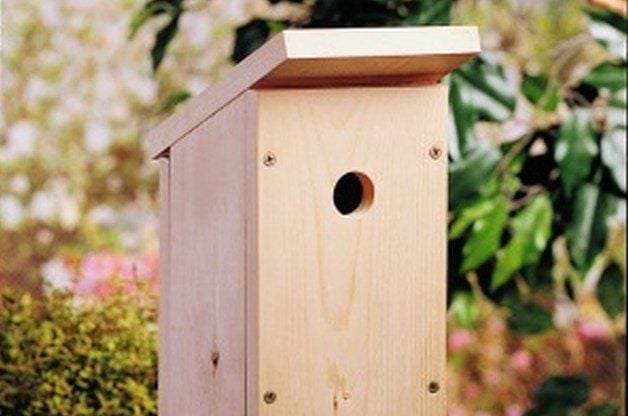
Materials:
- One 5-foot 1- x 6-inch No. 2 pine board
- 1-5/8-inch galvanized deck screws
- 2-inch galvanized finishing nails
- Power drill
- Appropriate-size spade bit
- Hand saw
Step-By-Step Instructions:
Step 1
Using the full width of the 1-inch x 6-inch board, cut out the pieces as shown in the board layout diagram.Step 2
Attach the front to the sides with 1-5/8-inch deck screws. Predrill the holes in the front piece to prevent the wood from splitting. After nesting season when it's time to clean out the birdhouse, remove these screws for easy access.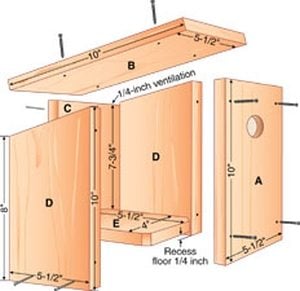
Step 3
Attach the back to the sides with 2-inch finishing nails. Predrill the holes, making sure each one is straight.Step 4
Cut about 1/2 inch off each corner of the floor for drainage.Step 5
Recess the floor 1/4 inch up from the bottom of the house, then attach it with 2-inch finishing nails from the sides and back. Do not nail the floor from the front or you won't be able to open it for cleaning.Step 6
Attach the roof to the sides with 1-5/8-inch deck screws. That’s it!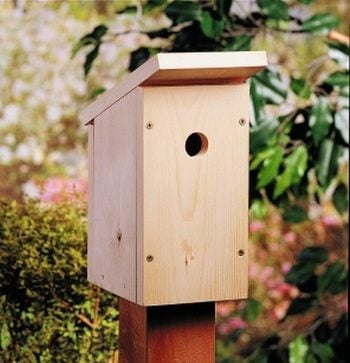
~~~~~~~~~~~~~~~~~~~~~~~~~~~~~~~~~~~~~~~~~~~~~~~~~~~~~~~~~~~~~~~~~~~
(Please do not paint the inside of your birdhouse - birds don't like the smell of paint! cm)
Will pressure-treated pine work for the wren house ?
ReplyDelete